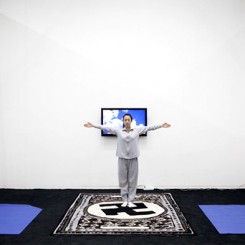“MadeIn Company” (on-site studio practice)
Minsheng Art Museum (bldg F, NO.570 West Huaihai Road Changning, Shanghai) Nov 17, 2012 – Jan 2, 2013
Xu Zhen, the dark horse of contemporary Chinese art, has constantly been reflecting on the relationship between art and commerce through his works over the last few years. At a time when financial magazines can influence art with their lists of the “most influential” and consumerism has become an overwhelming force, Xu Zhen had a few years back made a final statement in his most comprehensive work: relinquishing his identity as an artist and establishing a business to manufacture artistic creativity — MadeIn Company. Xu’s role as a creator of artworks has been transformed into being the founder and general manager of an art company, both leader and strategizer — a corporate CEO.
Since its launch in 2009, MadeIn has leveraged the dynamic creativity and productivity of its team to participate in various exhibitions inside and outside China. Works bearing the distinctive MadeIn style seem to be popping up everywhere. From museums to galleries, from art fairs to public spaces, we see the purposely stylized silhouettes of their cheap Styrofoam sculptures, their exquisitely painted photorealistic scenes of impoverished rural lives, and their religious/exercise videos compiling various techniques of physical and spiritual wellness. All of these artworks challenge our understanding of contemporary art conceptually and ideologically. What is MadeIn doing? With artistic inspiration as their raw material, is their workshop manufacturing art or attitude? Are their frequent appearances in exhibitions and the mass production of artwork a release of their creative spirits or a marketing strategy to raise the profile of their brand? These would be sensitive and avoided questions in any other case in art, but when it comes to MadeIn, they roll easily off our tongues. On Nov 17, “MadeIn Company” opened at the Minsheng Art Museum. Once again taking over parts of the museum, this time, they have set up the daily operations of their art production company in the most hallowed space of a museum — all of this in real time, no less. So, welcome, viewers, to the MadeIn Company show!
The white walls of the museum have been partitioned into various cubicles reminiscent of an office. Pictures and sketches are scattered over desktops, and complete and incomplete canvases lean against the walls. Some people are zoning out in front of their computers, some are chatting, and others are practicing MadeIn’s signature yoga-like exercises. An enthusiastic woman who said she was the company’s human resources manager answers the audience’s many questions. Another space has been covered entirely by a plastic tarp; there are employees inside working on something, and the smell of paint is overwhelming. I recognize some works from MadeIn’s past exhibitions, like the sculpture of a black figure being packaged — perhaps to be shipped off to an exhibition or collector. So it is true, this is MadeIn Company; these scenes from their working life will continue until the end of the year, and they are still in talks about how they are going to end this exhibition.
The staging of MadeIn within an art museum does not signify the company’s incorporation into the ”system”; on the contrary, the spirit is more “anti-art.” The much-favored MadeIn is capitalizing on this exhibit as another opportunity to release their “Corporate Strategy.” In the 60s, American art critic Arthur Danto proposed the concept of “Art Worlds,” this pluralistic phrase encompassing the entire process art passes through, from its creation to its distribution. The notion includes the most prestigious museums, art institutes, curators, commercial galleries, private collectors, art critics, the public, and ultimately, the source of all these entities — the creativity of the artists themselves. However, value in art does not simply rely on the art itself, but on the innate qualities of “artness” and “worldness” a piece possesses. In these “Art Worlds,” the artist — like the public, critics, or collectors — is an important factor in the continuum sustaining a work’s “artness” and “worldness.” The various performances of MadeIn are designed to examine this “Art World” from angles at times humorous and playful, and other times, solemn and serious. If the exquisitely crafted, gilt-framed oil painting of a poverty-ridden family in Guizhou had not ultimately been purchased by a collector and then placed on the wall of a lavishly furnished mansion, MadeIn’s moral message could not be broadcast.
MadeIn differs from Science Ltd., the company set up by the British conceptual artist Damien Hirst to manufacture signed copies of his works. MadeIn is the corporate result of collective creation; it disperses the last traces of the myth that proclaims the artist as individual genius. In a society dominated by consumerism, MadeIn maintains its anti-art stance while endeavoring to carve out a place in the art world. What this museum show means for MadeIn is still unclear; is it a public promotion of art as product, or a financial briefing before MadeIn Co. goes public? With MadeIn, anything can happen.

